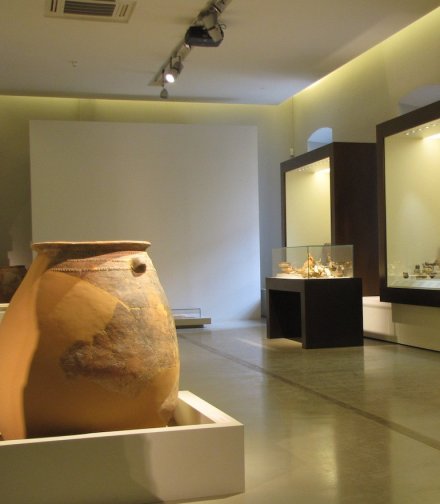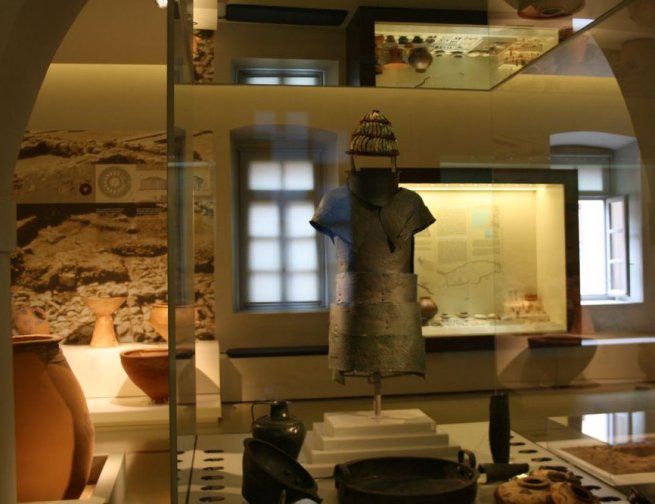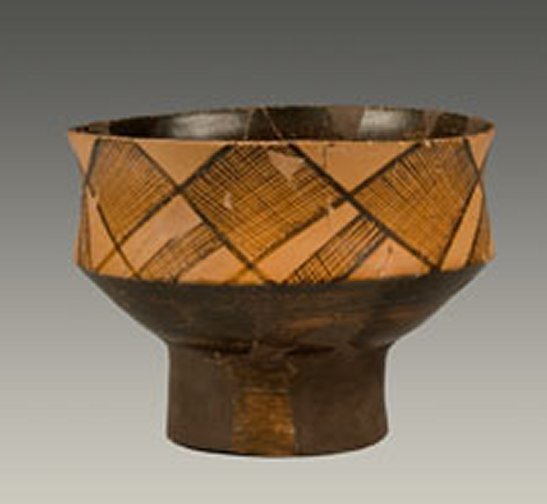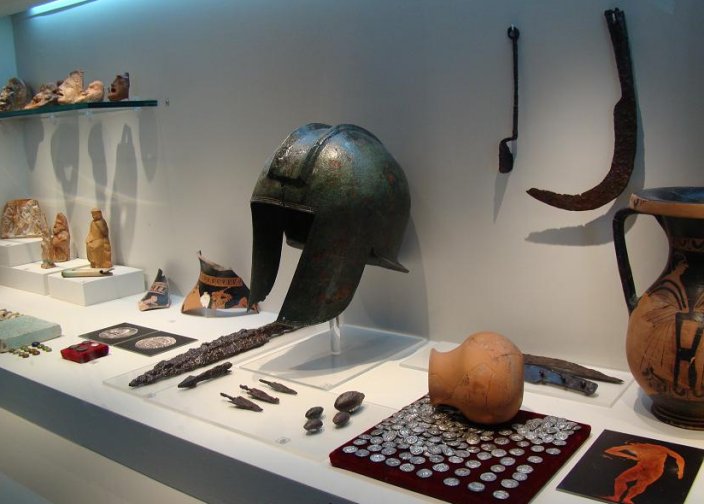The Archeological Museum . . .
Syntagma Square, 21100 NafplioThe Archaeological Museum of Nafplio is housed in an imposing Venetian stone building, which, with its impressive size and austere, symmetrical shape, closes off the west side of Syntagma Square. The building was erected in 1713, during the second Venetian occupation, by the naval overseer Augustinus Sagredo as a storehouse for the fleet, as attested by the Latin marble inscription on the façade. It is one of the most beautiful and best preserved buildings from the Venetian period in Greece.
The museum's new permanent exhibition is housed in two similarly designed rooms on two floors of the building and is divided into thematic sections that present the civilisations that developed in Argolis from prehistory to late antiquity.
The museum's oldest exhibit is the complex of Palaeolithic hearths from the rock shelters in the Kleisoura Gorge in Prosymna (32000-21000 BC).
The Early Bronze Age (3300-2100/2000 BC) is represented by exhibits from Tiryns, Assini, Berbati and Palea Epidaurus. Typical ceramics of the period, stone, clay and bronze seals, clay seals, bone tools, Early Cycladic marble figurines and the clay hearth from Berbati are on display. A special place among them is occupied by the unique freezer from Tiryns.
Vessels and other artefacts from the Middle Helladic settlements of Asini, Proonia of Nafplio, Midea, Tiryns and Berbati cover the entire chronological range of the Middle Helladic period (2100/2000-1600 BC), a civilisation that forms the background for the Mycenaean period.
The structure of Mycenaean palace power and administration is outlined on the basis of finds from the important Mycenaean centres of Tiryns, Midas and Assinia. Of particular note are cult implements and figurines, including the impressive female figures on wheels from Tiryns and Midea, as well as the famous "Archon of Asina", Linear B tablets and storage amphorae, remains of workshops (matrices, semi-precious or unworked semi-precious stones), as well as Mitannic seal cylinders, a copper talent, objects made of faience, electrum and alabaster, which are irrefutable witnesses to extensive Mycenaean trade.
The other exhibits come from the cemeteries of the chamber tombs of Evaggelistria of Nafplio, Assinia, Dendron, Old Epidaurus and the vaulted tomb of Kazarma. Vessels made of stone, metal and clay, ivory figurines, seal stones and jewellery made of gold, semi-precious stones, electrum, faience and glass shed light on burial practices and reflect the stratification of Mycenaean society. Of particular note are the amphora craters with representations of a chariot and a guitarist respectively, and the basket - a brook with a goat from Evaggelistria of Nafplio.
The bronze armour of Dendron, the museum's main exhibit, is displayed in a separate showcase, along with the other impressive grave goods from the tomb in which it was found, parts of the warrior's armour, bronze utensils and clay vessels.
In the hall on the second floor, the presentation begins with the material remains from the Iron Age. The bronze helmet from the famous sub-Mycenaean tomb of Tiryns (11th century BC) is outstanding.
The Geometric Period is represented by the finds from the tombs of Pronia of Nafplio, Tiryns, Asini and Berbatius. The horses with the rider, the most typical iconographic motif of the Argives, represent the heroic spirit, while depictions of caravans, ritual dances, animals and birds shape the image of the Homeric period.
The cults of the Archaic period are presented mainly on the basis of the finds from Tiryns. Human female deities, female anathemas, an aspidophorus rider, miniature vases, flowers, fruits and wreaths are associated with the cult of Hera, while bronze models of skulls and tibias as well as parts of craters from the 5th century BC with dedicatory inscriptions are associated with the cult of the goddess Athena. Of particular interest are the famous clay votive shields with mythological scenes and the 7th century BC clay ritual masks from the so-called "Vothro" of Tiryns, as well as the bronze Kouros from the Kefalari of Argos (560-540 BC).
This is followed by a section on the ancient cities of Epidaurus, Hermione, Aliaeon and ancient Assinia. Clay and glass vases, figurines, gold jewellery, slingshots, bronze mirrors and utensils outline aspects of life and death in these ancient cities. Among them, the bronze statuette of a girl (c. 600 BC) from the sanctuary of Artemis in the city of Epidaurus, the bronze mirror in the type of the Caryatids (490-470 BC) from Hermione and three corroded iron keys from the temple of Apollo of the Aelyrians stand out.
The tour concludes with a visit to a 6th century AD farmhouse in Pyrgouthi, in the valley of Berbatius. On display are implements and tools related to wine making and other agricultural activities of the inhabitants.
The exhibition concludes with the collections of the museum's donors. Attic, Boeotian and Corinthian vases and figurines from the collections of the Philarchic donors Glymenopoulou, Potamianos, Archbishop Nikandros and Thermogiannis are presented.
A prominent place among them is occupied by the Panathenaic amphorae, a work by the painter of Mastro (530-520 BC). The scene of the murder of Clytemnestra by Orestes is depicted on an Attic red-figure hydria (c. 440 BC). A Boeotian pseudo-reddish cave dog (425-400 BC) represents a parody of the well-known myth of Odysseus' hospitality in Circe's palace.
OPENING HOURS
Monday - Sunday: 8.30 a.m. - 4.00 p.m. (Tuesday: closed)
 |
 |
 |
 |
 |
 |